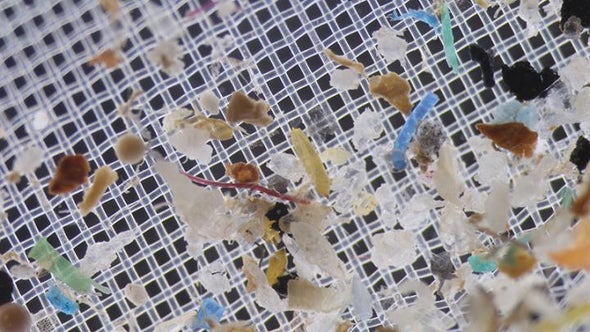(单词翻译:单击)
听力文本
This is Scientific American's 60-second Science, I'm Annie Sneed.
Plastic is lightweight, malleable, durable. But it has also become so widespread that it's ending up in a lot of unwanted places—including our own bodies. That's according to a new study, which found that humans are consuming a shocking amount of so-called "microplastics".
"Microplastics, the kind of current working definition, is plastic less than five millimeters. So people commonly equate that to something like a grain of rice or a sesame seed and down in terms of size class. I will say that most of the microplastics that people are interacting with are quite a bit smaller than the sesame seed size, which I think always kinds of shocks people when we start talking about the numbers because they kind of can't see a lot of these things, at least with the naked eye."
Kieran Cox, a PhD candidate in marine biology at the University of Victoria in Canada and one of the authors of the study, which is in the journal Environmental Science & Technology.
Microplastics come from numerous sources. They can be pieces shed from larger plastics or they may have been designed small to begin with.

For their study, Cox and his team pulled together past scientific literature that calculated the number of microplastics in things we commonly consume, such as in tap and bottled water, sugars, seafood—even in the air that we breathe. This analysis helped them figure out the baseline amount of microplastics that people are consuming every year. They couldn't include common foods like beef, poultry, vegetables and dairy in their analysis because data on them doesn't exist yet. In fact, their study could account for only 15 percent of people's caloric intake.
Even missing the majority of what people swallow, the research revealed that—at the very least—humans appear to consume somewhere between 74,000 and 121,000 microplastic particles every year. That number goes up for people drinking bottled water rather than tap water. Now, is all this plastic safe to ingest? We simply don't know yet.
"This is kind of the first estimate of dose, you could say, right? So if you're thinking in terms of toxicology and ecotoxicology, dose is a very important factor to think about, and so this kind of presents the first estimate, but it is very much an underestimate because of what we don't know."
Thanks for listening for Scientific American — 60-Second Science. I'm Annie Sneed.
参考译文
这里是科学美国人——60秒科学系列,我是安妮·斯尼德。
塑料重量轻,可塑性强,经久耐用。但塑料的分布已经如此广泛,以致于其最后会留在许多不应该出现的地方——包括我们自已的身体。这是一项新研究得出的结论,该研究发现,人类正在消耗数量惊人的所谓的“微塑料”。
“依据现有的惯用定义,微塑料是小于5毫米的塑料。所以人们通常认为其相当于米粒或芝麻和更小的东西。我会说,大多数与人进行相作用的微塑料都比芝麻小得多,我认为当我们开始谈论这些数字时,总会让人们震惊,因为他们看不到许多这些东西,至少用肉眼看不到。”
基兰·考克斯是加拿大维多利亚大学海洋生物学的博士研究生,也是这项发表在《环境科学与技术》期刊上的研究的作者之一。
微塑料的来源有很多。可能是较大塑料上脱落的碎片,也可能是最初就设计得很小。
为了研究,考克斯和团队收集了以往的科学文献,这些文献计算了我们日常消耗物品中的微塑料含量,比如自来水、瓶装水、糖和海鲜,甚至还有我们呼吸的空气。这一分析帮助他们算出人们每年消耗的微塑料的基本量。他们无法将牛肉、家禽、蔬菜和乳制品等常见食品纳入分析,原因是目前没有相关数据。事实上,他们的研究只占人们热量摄取的15%。
即使没有涵盖人类摄入的大部分食物,研究依然揭示出,人类每年消耗的微塑料颗粒至少也有7.4万到12.1万。由于人们现在开始饮用瓶装水而不是自来水,这一数字仍在上升。那摄入这些塑料安全吗?我们根本不知道。
“你可以说,这是对剂量的初步估计,对吧?所以,如果从毒理学和生态毒理学角度考虑,剂量是一个非常重要的因素,这是初步估计,但由于我们所不知道的数据,这个数字被大大低估了。”
谢谢大家收听科学美国人——60秒科学。我是安妮·斯尼德。
译文为可可英语翻译,未经授权请勿转载!
重点讲解
重点讲解:
1. to begin with 最初;刚开始;
It was great to begin with but now it's difficult.
一开始非常好,但现在可就难了。
2. account for (数量或比例上)占;
Computers account for 5% of the country's commercial electricity consumption.
计算机占去该国商业用电的5%。
3. at the very least (数量)至少,不少于;
Normally it has only had eleven or twelve members in all. Now it will have seventeen at the very least.
通常总共只有十一二个会员。现在将至少有十七个。
4. go up (价格、数量或水平)上涨,上升;
Interest rates went up.
利率上调了。


